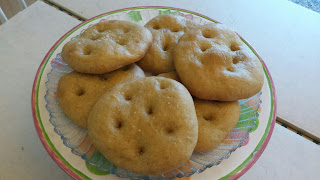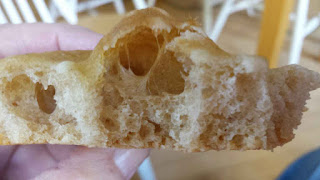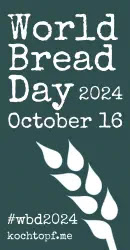Hooray! I am the December Kitchen of the Month! Because
the holiday season is here, I chose a celebration bread that would light up the
dark days. I decided on Lussekatter, or
St. Lucia Buns, or Saffron Buns.
St. Lucia's Day is celebrated most commonly in Italy and in
Scandinavia. In Scandinavia, it falls on December 13th, considered
to be the shortest day of the year (Julian calendar). Lucia means light, and the saffron provides
the color of light. In Swedish
tradition, young girls wear a crown of candles and wake their families bearing
Lussekatter, special sweet yeasted buns flavored with saffron and studded with
currants or raisins. The shape is said
to resemble the curl of a cat’s tail.
I researched a number of recipes, all
with slight variations. Some added dried
fruit to the dough; some just used the fruit as decoration. Some added cardamom along with the saffron;
others said ‘no way’ that cardamom was used.
There were variations in the amount of saffron used. There were alternatives to the saffron, such
as turmeric. Some added the saffron
directly to the dough; some steeped it in warm milk or rum (if you want an
extra kick!), or crushed it beforehand.
This particular recipe calls for the
least amount of sugar, enough to add flavor and texture, but not so much that
the rolls are too sweet or dense. I
fiddled with the recipe to reflect how I bake.
After the initial rise, I divided the
dough into two portions, using one portion right away, and chilling the other
one overnight.
Batch #1: I used dried cherries, putting them on the
rolls just before baking. As you can see, one cherry jumped ship while in the
oven.
Batch #2: I used the chilled dough, putting the currants
on before final rise.
There’s not much difference between
the batches, although the chilled dough was a bit easier to shape. There might also have been a tiny difference
in texture.
My recipe version:
St. Lucia Saffron Buns
This recipe makes 12 to 14 good
sized buns. You can easily double the recipe.
·
Prep time: 2 hours, 30 minutes (or
overnight)
·
Cook time: 12 minutes
- Yield: Makes 12 to 14 buns
Ingredients
- 3/4 cup milk (175 ml)
- 1/4 teaspoon saffron threads
- 1 teaspoon plus 1/4 cup (50 g)
white, granulated sugar
- One 1/4-ounce packet active dry
yeast
- 3 1/2 to 4 cups (490 g to 570 g)
all-purpose flour
- 1/2 teaspoon kosher salt
- 1/2 teaspoon ground cardamom
- 1/4 cup (1/2 stick, 4 Tbsp, 56 g)
unsalted butter, softened
- 1/4 cup of sour cream
- 2 large eggs
- Raisins, currants, dried cherries
Glaze
Method
1 Heat milk, saffron,
sugar, and butter: In
a small pot, heat the milk, saffron, and 1 teaspoon of sugar together until the
milk is steamy. Remove from heat and stir to dissolve the sugar. Stir in the
butter until melted. Let cool until about 115°F, or warm to the touch, but not
hot.
2 Whisk yeast, flour,
sugar, salt, cardamom:
In the bowl of a stand-up mixer, whisk together 3 1/2cups (490 g) of the flour,
yeast, remaining 1/4 cup of sugar, salt and ground cardamom (if using).
4 Make a well in the
center of the flour and add the milk-saffron-butter mixture, the eggs, and the
sour cream. Mix
the ingredients until well incorporated.
5 Knead the dough: Switch to the dough hook of your
mixer (if using, otherwise knead by hand). On low speed, start to knead the
dough. Slowly add additional flour, a tablespoon at a time, kneading to
incorporate after each addition. Do this until the dough is still a little
sticky to the touch, but does not completely stick to your hands when you
handle it.
6 Let dough rise: Shape the dough into a ball and place
in a large bowl. Cover with plastic wrap. (Note
at this point you can make ahead and refrigerate overnight if you wish.)
Let sit in a warm place for 1
to 2 hours, until the dough has doubled in size. (One way to tell that the dough
is ready is that you poke your finger in it and it takes quite a bit of time
for the indentation left by your finger to go away.)
7 Form dough into S
shapes: When the
dough has doubled in size, gently press it down and knead it a couple of times.
Break off a piece and form it into a ball about 2 inches wide (60 to 70 grams
if you are weighing, mine were roughly 65 grams). Roll the ball out into a
snake, about 14 inches long.
Then Curl the ends in
opposite directions, forming an "S" with spirals at each end. Place
on a lined baking sheet and repeat with the rest of the dough.
8 Let sit for
second rise:
Cover with plastic wrap and place in a warm spot until the dough shapes double
in size, 30 minutes to an hour.
9 Brush with egg wash, place raisins
on buns: Preheat oven to 400°F (205°C).
Using a pastry brush, brush some beaten egg over the tops and sides of the
uncooked buns. Place raisins in the centers of the "S" spirals.
10 Bake: Place in the oven and bake at 400°F (205°C) for about 10 to
11 minutes (turning halfway through cooking to ensure even browning), until the
buns are golden brown.
Remove from oven and let cool for 5
minutes before eating.
Original recipe (from Simply Recipes):
St. Lucia Saffron Buns
This recipe makes 12 to 14 good
sized buns. You can easily double the recipe. Note the cardamom is optional.
I've made these buns with and without a little cardamom and I prefer them with.
I'm guessing it's more traditional without.
- Prep time: 2 hours, 30 minutes
- Cook time: 12 minutes
- Yield: Makes 12 to 14 buns
Ingredients
- 3/4 cup milk (175 ml)
- 1/2 teaspoon saffron threads (or
¼ teaspoon)
- 1 teaspoon plus 1/4 cup (50 g)
white, granulated sugar
- One 1/4-ounce packet active dry
yeast (check the expiration date on the package to make sure it's still
good!)
- 3 1/2 to 4 cups (490 g to 570 g)
all-purpose flour
- 1/2 teaspoon kosher salt
- The seeds from 3 cardamom pods,
ground (optional) (1/2 teaspoon ground)
- 1/4 cup (1/2 stick, 4 Tbsp, 56 g)
unsalted butter, softened
- 1/4 cup of sour cream (or quark
if available)
- 2 large eggs
- Raisins
Glaze
Method
1 Heat milk, saffron,
sugar: In a
small pot, heat the milk, saffron, and 1 teaspoon of sugar together until the
milk is steamy. Remove from heat and stir to dissolve the sugar. Let cool until
about 115°F, or warm to the touch, but not hot.
2 Sprinkle the yeast
over the warm saffron-infused milk and let sit for 5 to 10 minutes until foamy.
3 Whisk flour, sugar,
salt, cardamom:
In the bowl of a stand-up mixer* whisk together 3 1/2cups (490 g) of the flour,
remaining 1/4 cup of sugar, salt and ground cardamom (if using).
*You can make this recipe
without a mixer, for me it's just a bit easier with one.
4 Make a well in the
center of the flour and add the yeast milk saffron mixture, the eggs, the
butter, and the sour cream.
Mix the ingredients until well incorporated.
5 Knead the dough: Switch to the dough hook of your
mixer (if using, otherwise knead by hand). On low speed, start to knead the
dough. Slowly add additional flour, a tablespoon at a time, kneading to incorporate
after each addition. Do this until the dough is still a little sticky to the
touch, but does not completely stick to your hands when you handle it.
6 Let dough rise: Shape the dough into a ball and place
in a large bowl. Cover with plastic wrap. (Note
at this point you can make ahead and refrigerate overnight if you wish.)
Let sit in a warm place for 1
to 2 hours, until the dough has doubled in size. (One way to tell that the
dough is ready is that you poke your finger in it and it takes quite a bit of
time for the indentation left by your finger to go away.)
7 Form dough into S
shapes: When the
dough has doubled in size, gently press it down and knead it a couple of times.
Break off a piece and form it into a ball about 2 inches wide (60 to 70 grams
if you are weighing). Roll the ball out into a snake, about 14 inches long.
Then Curl the ends in
opposite directions, forming an "S" with spirals at each
end. Place on a lined baking sheet and repeat with the rest of the dough.
8 Let sit for
second rise:
Cover with plastic wrap and place in a warm spot until the dough shapes double
in size, 30 minutes to an hour.
9 Brush with egg wash, place raisins
on buns: Preheat oven to 400°F (205°C).
Using a pastry brush, brush some beaten egg over the tops and sides of the
uncooked buns. Place raisins in the centers of the "S" spirals.
10 Bake: Place in the oven and bake at 400°F (205°C) for about 10 to
11 minutes (turning halfway through cooking to ensure even browning), until the
buns are golden brown.
Remove from oven and let cool for 5
minutes before eating.
If you wish to bake with us as a
Buddy, please submit your post and photos by December 29th to be
included in the roundup and earn your baking badge. Send to jahunt22 at gmail.com.
Visit the other Babes to check out their versions of Lussekatter.












